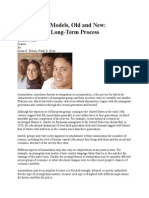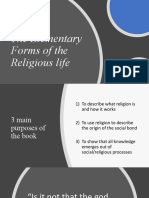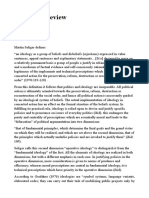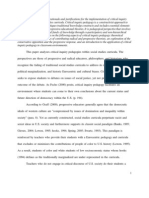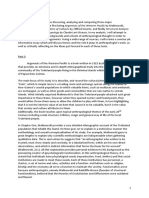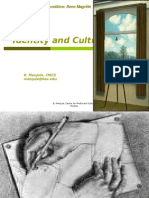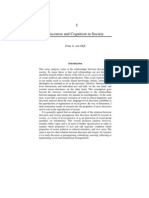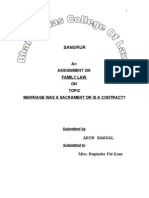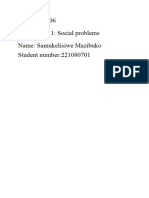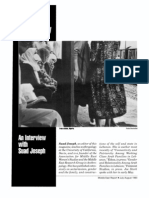Ethnicity
Ethnicity
Uploaded by
Nur Laila AbasCopyright:
Available Formats
Ethnicity
Ethnicity
Uploaded by
Nur Laila AbasCopyright
Available Formats
Share this document
Did you find this document useful?
Is this content inappropriate?
Copyright:
Available Formats
Ethnicity
Ethnicity
Uploaded by
Nur Laila AbasCopyright:
Available Formats
ETHNICITY, RACE AND NATION This chapter will be concerned with ethnicity, race and nationality as forms of cultural
identity. These are regarded as discursive-performative constructions. That is, ethnic, racial and national identities are contingent and unstable cultural creations with which we identify. They are not universal or absolute existent things. A. Race and Ethnicity In this chapter, race refers to alleged biological and physical characteristics, the most obvious of which skin is pigmentation. These attributes, frequently linked to intelligence and capabilities, are used to rank racialized groups in a hierarchy of social and material superiority and subordination. These racial classifications, constituted by and constitutive of power, are at the root of racism. a. Racialization Racialization or race formation encompasses the argument that race is a social construction and not universal or essential category of biology or culture. Races do not exist outside of representation but are formed in and by it in a process of social and political power struggle. In Britain, America and Australia the historical formation of race is one of power and subordination so that people of colour have occupied structurally subordinate positions in relation to every dimension of life chances. British Afro Carribeans, African-Americans and Australian Aboriginal peoples have occupied lower paid, less skilled jobs, have been disadvantaged in the housing market, at school and in media and cultural representations. In this context, racialization has been inherently racist for it involves forms of social, economic and political subordination which are lived through the categories and ideology of race. b. Different Racism The meaning or race differs over time and across space. For example, it has been argued that the new racism in Britain relies not on biological discourses of superiority, as in South African apartheid, but on cultural differences which exclude black people from being fully a part of the nation. In addition, the meaning of race differs between America and Britain. In Britain, the relatively homogeneous white character of the in situ population was disturbed is disturbed in the 1950s by the arrival of migrants from Carribean and Indian sub-continent, making questions of national identity a crucial category through which racialization operated.
However, west has argued that the history of the modern United States begins with the dispossession and genocide of Native American peoples and continuous through the long history of slavery. Thus, questions of race are posed at the very inceptions of the US in ways which are more long standing, but less concerned with nationality, than in Britain. c. The Concept of Ethnicity Ethnicity is a cultural concept centered on the sharing of norms, values, beliefs, cultural symbols and practices. Ethnicity is formed by the way we speak about group identities and identify with the signs and symbols which constitute ethnicity. Ethnicity is a relational concept concerned with categories of selfidentification and social ascription. What we think of as our identity is dependent on what we think we are not. Consequently, ethnicity is best understood as a process of boundary formation constructed and maintained under specific socio-historical conditions. However, the concept of ethnicity is without its problems of usage and it remains a contested term. d. Ethnicity of Power Ethnicity is constituted through power relations between groups. It signals relations of marginality, of the center and the periphery, in the context of changing historical forms and circumstances. Here, the centre and the margin are to be grasped through the politics of representation. Discourses of the ethnic centrality and marginality are commonly articulated with those of nationality. B. National Identities The modern nation-state is a relatively recent invention, for most of the human species have never participated in any kind of state nor identified with one. The nation state, nationalism and national identity as collective forms of organization and identification are not naturally occurring phenomena but contingent historical cultural formations. The nation state is a political concept which refers to an administrative apparatus deemed to have sovereignty over a specific space or territory within the nation state system. National identity is a form of imaginative identification with the symbols and discourses of the nation state.
a.
Narratives of Unity Cultures are not static entities but are constituted by changing practices and meanings which operate at different social levels. Any given national culture is understood and acted upon by different social groups, so that governments, ethnic groups and classes may perceive it in different ways. Representations of natural culture are snapshots of the symbols and practices which have been foregrounded at specific historical conjunctures for particular purposes by distinctive groups of people. National identity is a way of unifying cultural diversity. That unity is constructed through the narrative of the nation by which stories, images, symbols and rituals represent shared meanings of nationhood. Narratives of nationhood emphasize the traditions and continuity of the nation as being in the nature of things along with a foundational myth of collective origin.
b.
The Imagined Community National identities are intrinsically connected to, and constituted by form of communication. For Anderson (1983), the nation is an imagined community and national identity a construction assembled through symbols and rituals in relation to territorial and administrative categories. According to Anderson, the mechanized production and commodification of books and newspapers, allowed vernacular languages to be standardized and disseminated and providing the conditions for the creation of a national consciousness. The processes of print capitalism thus fixed a vernacular language as the national language and made possible a new imagined national community.
C. Diaspora and Hybrid Identities Diaspora focuses attention on travel, journeys, dispersions, homes and borders in the context of questions about who travels, where, when, how and under what circumstances. Diaspora is a relational concept referring to configurations of power which differentiate diasporas internally as well as situate them in relation to one another. a. The Idea of Diaspora According to Gilroy (1997), the divided network of related peoples which form the diaspora is one characteristically produced by forced dispersal and reluctant scattering. Diaspora is focused less on the equalizing, proto-democratic force of common territory and more on the social dynamics of remembrance and commemoration defined by a strong sense of the dangers involved in forgetting the location of origin and the process of dispersal.
b.
Types of Hybridity There are two types of hybridity, structural and cultural hybridation. Structural hybridity refers to a variety of social and institutional hybridity and cultural hybridity which ranges from assimilation, through form of separation to hybrid that destabilize and blur cultural boundaries.
D. Race, Ethnicity, Representation Representation involves questions of inclusion and exclusion and as such is always implicated in questions of power. Dyer (1977) points us to a useful distinction between types and stereotypes. Types act as general and necessary classificatio of ns persons and roles according to local cultural categories. While stereotypes are regarded as vivid but simple representations which reduce persons to a set of exaggerated, usually negative characteristics. Types are instances which indicate those who live by the rule of society and those whom the rules are designed to exclude. Stereotypes concern those excluded from the normal order of things and simultaneously establish who is us and who is them. Thus, stereotyping reduces, essentializes, naturalizes and fixes difference. E. Postcolonial Literature Postcolonial literature is that works produces by the peoples of former European colonies. While the term postcolonial might refer to literature produces after colonialization, it is taken here to include the colonial discourse itself, that is, the world both during and after European colonization. Postcolonial theory explores postcolonial discourses and subjectivity, power, subalterns, hybridity and creolizations. F. Domination and Subordination Domination and subordination is a relationship which occurs not only between nations or ethnic groups but also within them. The emphasis on ethnicity in postcolonial theory literature can mask the power relation of gender. G. Hybridization and Creolization The hybridyzation and creolization of language, literature and cultural is a common theme of postcolonial literature and theory marking a certain meeting of minds with postmodernism. Creolization stresses language as a cultural practice and the inventions of new modes of expressions particular to itself.
You might also like
- Racism & Capitalism. Chapter 1: Racism Today - Iggy KimDocument5 pagesRacism & Capitalism. Chapter 1: Racism Today - Iggy KimIggy KimNo ratings yet
- Research Methodology PPT Module 1 SociologyDocument106 pagesResearch Methodology PPT Module 1 Sociologylucifer morningstarNo ratings yet
- Ethics - Internet Encyclopedia of PhilosophyDocument17 pagesEthics - Internet Encyclopedia of PhilosophyPetar ŽivkovićNo ratings yet
- Robert J.C. Young. White Mythologies WriDocument4 pagesRobert J.C. Young. White Mythologies WriRonaldo Oliveira de Castro100% (1)
- Postcolonial InterventionsDocument20 pagesPostcolonial Interventionssaahmed1No ratings yet
- Ibsen S Men in Trouble Masculinity and Norwegian ModernityDocument17 pagesIbsen S Men in Trouble Masculinity and Norwegian ModernityfredNo ratings yet
- Assimilation ModelsDocument10 pagesAssimilation ModelsSamantha SwiftNo ratings yet
- The Elementary Forms of The Religious LifeDocument23 pagesThe Elementary Forms of The Religious LifeMORRIS ANUNDANo ratings yet
- CONSTRUCTIONISMDocument15 pagesCONSTRUCTIONISML RaNo ratings yet
- The Elementary Form ofDocument62 pagesThe Elementary Form ofsarkar salamNo ratings yet
- Lecture 1 What Is CultureDocument12 pagesLecture 1 What Is CulturedivyaNo ratings yet
- Ivan Illich: Deschooling, Conviviality and Lifelong LearningDocument17 pagesIvan Illich: Deschooling, Conviviality and Lifelong LearningManoj DavangereNo ratings yet
- Indian Thinkers, Village Studies, Modernization of Indian Tradition EtcDocument27 pagesIndian Thinkers, Village Studies, Modernization of Indian Tradition EtcPaladugu Charantej100% (1)
- Edward Said and The Cultural Politics of EducationDocument17 pagesEdward Said and The Cultural Politics of Educationwhereami0% (1)
- Sample ProposalDocument3 pagesSample ProposalDennis Vigil Caballero100% (1)
- AssimilationDocument3 pagesAssimilationEric Kaufmann100% (1)
- Literature Review: IdeologyDocument11 pagesLiterature Review: IdeologyKyteNo ratings yet
- Anthro of Development - Mosse 2013Document23 pagesAnthro of Development - Mosse 2013Letícia Cesarino100% (1)
- When Sex and Power Collide An Argument FDocument25 pagesWhen Sex and Power Collide An Argument Fsasori89No ratings yet
- EMILE DURKHEIM The Elementary Forms of The Religious LifeDocument32 pagesEMILE DURKHEIM The Elementary Forms of The Religious Lifeapi-3769712No ratings yet
- Galtung - Theory of Conflict PDFDocument37 pagesGaltung - Theory of Conflict PDFmihamarietaNo ratings yet
- Social AnthropologyDocument11 pagesSocial Anthropologybakhtawar naseebNo ratings yet
- RIchard Wright - Psychiatry Comes ToHarlemDocument4 pagesRIchard Wright - Psychiatry Comes ToHarlemdanthetoasterNo ratings yet
- Incorporating Critical Inquiry Pedagogy in Social Studies CurriculumDocument27 pagesIncorporating Critical Inquiry Pedagogy in Social Studies Curriculumnbowling100% (7)
- Gerontology Chapter 1 IntroDocument9 pagesGerontology Chapter 1 IntroSJNo ratings yet
- Concept of PostmodernismDocument7 pagesConcept of Postmodernismumair saleemNo ratings yet
- Fanon and Critical Disability StudiesDocument9 pagesFanon and Critical Disability StudiesPascal Emmer100% (1)
- Peter L.callero. The Sociology of The SelfDocument21 pagesPeter L.callero. The Sociology of The SelfcrmollNo ratings yet
- Critical Realism: Locke and DescartesDocument6 pagesCritical Realism: Locke and Descartesmoschub50% (2)
- Anthropology EssayDocument6 pagesAnthropology Essayspurtill1798No ratings yet
- Social AnthropologyDocument2 pagesSocial AnthropologyNicole Williams0% (1)
- Review Essay: Neoliberalism, Education and Strategies of ResistanceDocument13 pagesReview Essay: Neoliberalism, Education and Strategies of ResistanceKathy SorrellNo ratings yet
- Assimilation TheoryDocument5 pagesAssimilation TheoryHector Perez PriorNo ratings yet
- Importance of Anthropological Religion StudiesDocument7 pagesImportance of Anthropological Religion Studiesdmedina2111100% (1)
- Quijano (2000) Colinality of PowerDocument49 pagesQuijano (2000) Colinality of PowerSokoHwang100% (1)
- Identity and Culture: The Human Condition: Rene MagritteDocument32 pagesIdentity and Culture: The Human Condition: Rene Magrittefebna80% (5)
- UntitledDocument187 pagesUntitledAlan Alaafin PaixãoNo ratings yet
- Multiculturalism - Meaning, Development and CharacteristicsDocument5 pagesMulticulturalism - Meaning, Development and CharacteristicsEnglish with I.QNo ratings yet
- Atkinson - 2007 - Beck - Individualization and The Death of Class - A CritiqueDocument18 pagesAtkinson - 2007 - Beck - Individualization and The Death of Class - A CritiqueDéberson JesusNo ratings yet
- What Is ModernityDocument20 pagesWhat Is ModernityUmair AhmedNo ratings yet
- ReligionDocument33 pagesReligionAngelica PioquidNo ratings yet
- Freedom, Causality, Fatalism and Early Stoic PhilosophyDocument32 pagesFreedom, Causality, Fatalism and Early Stoic PhilosophycaltrapsNo ratings yet
- Victims Perpetrators and Actors Revisite PDFDocument18 pagesVictims Perpetrators and Actors Revisite PDFAle LamasNo ratings yet
- Social Stratification in China IIAS - NL36 - 16Document1 pageSocial Stratification in China IIAS - NL36 - 16Gaston FeijooNo ratings yet
- Critical Evaluation of EthnographyDocument7 pagesCritical Evaluation of EthnographyDeepapriya VishwanathanNo ratings yet
- Discourse and Cognition in SocietyDocument21 pagesDiscourse and Cognition in SocietyDesislava ZarevaNo ratings yet
- Social GerentologyDocument205 pagesSocial GerentologyAsif Ali100% (1)
- History: Fernand BraudelDocument17 pagesHistory: Fernand BraudelGiorgos BabalisNo ratings yet
- Fuller PostmodernismAndSenoGumiraAjidarmaDocument85 pagesFuller PostmodernismAndSenoGumiraAjidarmaMontezumaNo ratings yet
- Introduction To Ethnicity and RaceDocument42 pagesIntroduction To Ethnicity and RacetrotskidNo ratings yet
- Doing Narrative Ethnography (JDG)Document5 pagesDoing Narrative Ethnography (JDG)Daniela Paz Canales OffenNo ratings yet
- Social Conflict Theory of Lewis A Coser and MethodologyDocument1 pageSocial Conflict Theory of Lewis A Coser and MethodologybasmaNo ratings yet
- Acculturation: Vviiggn NeetttteeDocument36 pagesAcculturation: Vviiggn NeetttteeVinit Gupta100% (1)
- Jensen2011 Chapter GlobalizationAndCulturalIdentiDocument17 pagesJensen2011 Chapter GlobalizationAndCulturalIdentiLaura RodriguezNo ratings yet
- Cosmopolitanism and PhilosophyDocument263 pagesCosmopolitanism and PhilosophyRoRoNo ratings yet
- Dembour - What Are Human RightsDocument21 pagesDembour - What Are Human RightsRosivaldo Toscano Júnior0% (1)
- Dev of Socio - by Srinivas and Panini 1973, SB, v22, n2, 179-215Document37 pagesDev of Socio - by Srinivas and Panini 1973, SB, v22, n2, 179-215bingoNo ratings yet
- What Is Critical Pedagogy?: A Summary of The Work of Paulo Freire & His ContemporariesDocument38 pagesWhat Is Critical Pedagogy?: A Summary of The Work of Paulo Freire & His ContemporariesS. Ma. Elisabeth Ngewi,rvmNo ratings yet
- Population and Society VI Sem BA SociologyDocument57 pagesPopulation and Society VI Sem BA SociologybirajNo ratings yet
- Democracy and Difference: Contesting the Boundaries of the PoliticalFrom EverandDemocracy and Difference: Contesting the Boundaries of the PoliticalNo ratings yet
- WomenMartyrsNaxalbariTo2010 Vol 2.pmdDocument255 pagesWomenMartyrsNaxalbariTo2010 Vol 2.pmdnpmanuelNo ratings yet
- Sample Essay in PoliticsDocument2 pagesSample Essay in PoliticsKris Elaine Gandia FiguracionNo ratings yet
- Slavoj Žižek SinicisationDocument4 pagesSlavoj Žižek SinicisationkafrinNo ratings yet
- Robber's Cave ExperimentDocument2 pagesRobber's Cave Experimentzuzu_zuzu96No ratings yet
- People First LanguageDocument8 pagesPeople First LanguageLemuel Anthony MosquitoNo ratings yet
- History & Background of Talcott ParsonsDocument1 pageHistory & Background of Talcott ParsonsthyatiraNo ratings yet
- Assignment 1 - MONTESDocument6 pagesAssignment 1 - MONTESTracy MontesNo ratings yet
- Engels Today - A Centenary AppreciationDocument223 pagesEngels Today - A Centenary AppreciationLeonardo Ferreira Guimaraes100% (2)
- Towards A Feminist Collectivism: Charlotte Perkins Gilman and The Nationalist Movement Marguérite CorporaalDocument15 pagesTowards A Feminist Collectivism: Charlotte Perkins Gilman and The Nationalist Movement Marguérite Corporaaljasper_gregoryNo ratings yet
- Nature of Job DiscriminationDocument3 pagesNature of Job Discriminationsimply_cooolNo ratings yet
- Hegemony & Ideology by Raymond Williams (From Keywords)Document7 pagesHegemony & Ideology by Raymond Williams (From Keywords)Deidre Morales100% (1)
- An Assignment On Family Law On Topic Marriage Was ADocument17 pagesAn Assignment On Family Law On Topic Marriage Was Aarunbnsal3507No ratings yet
- UntitledDocument2 pagesUntitledMaria Franchisca AsioNo ratings yet
- Why Do People ConformDocument21 pagesWhy Do People ConformABDOULIENo ratings yet
- Osmundo Pinho-The - Black - Male - Body - and - Sex - Wars - in - Brazil PDFDocument20 pagesOsmundo Pinho-The - Black - Male - Body - and - Sex - Wars - in - Brazil PDFMateo Armando MeloNo ratings yet
- Business Ethics Chapter - 2Document93 pagesBusiness Ethics Chapter - 2xisspm100% (1)
- Durkheim Full+Document79 pagesDurkheim Full+Orlando Umali100% (1)
- Education 15 - 5 - 2023Document34 pagesEducation 15 - 5 - 2023Azaa RegmiNo ratings yet
- Sociology 306Document6 pagesSociology 306Cindy NgwenyaNo ratings yet
- UCSP ActivityDocument6 pagesUCSP ActivityBlue LionsNo ratings yet
- Culture and Identity by Simon ClarkDocument20 pagesCulture and Identity by Simon ClarkParamitha Tika100% (3)
- The Evolution of Leadership Theory RevisedDocument10 pagesThe Evolution of Leadership Theory RevisedAndrada GrosuNo ratings yet
- D 0515 Paper II SociologyDocument16 pagesD 0515 Paper II SociologynehaNo ratings yet
- Phyzna Lamartine-Women & Work PaperDocument4 pagesPhyzna Lamartine-Women & Work Paperpurposely14No ratings yet
- Gender and Civil Society - An Interview With Suad JosephDocument5 pagesGender and Civil Society - An Interview With Suad JosephM. L. LandersNo ratings yet
- Socialism Heywood ChapterDocument42 pagesSocialism Heywood ChapterKarthick Padmanaban100% (1)
- Individual Movie Review (The Lady (2011) )Document7 pagesIndividual Movie Review (The Lady (2011) )Firdaus AdamNo ratings yet
- The Great Globalization DebateDocument11 pagesThe Great Globalization DebateJovenil BacatanNo ratings yet
- Andrew SayerDocument3 pagesAndrew SayermoschubNo ratings yet







